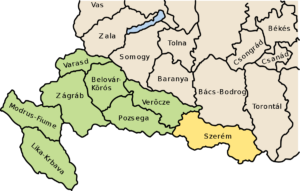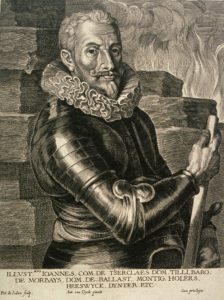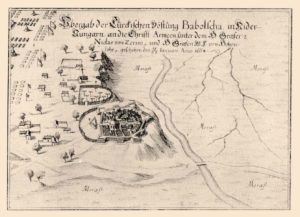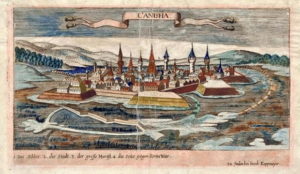The Long War, Part 26/ The siege of Kanizsa Castle, 1600

While the Imperials were in a defensive position due to their slowness in assembling, the Ottoman army set out against Hungary. Grand Vizier Ibrahim had his army winter in Belgrade so that he could march into the Szerémség (Sirmium) region on 10 August 1600.

They held a council at Eszék (Osiek), where they had originally planned to besiege Esztergom, but many pashas (mainly because of the complaints of the Bey of Szigetvár Castle) advised them to attack Kanizsa Castle. The Hungarian warriors had made too many raids and ambushes, and the logistical lines at Eszék were threatened.
Ibrahim sent his 20-25,000-strong vanguard to besiege Babócsa Castle on 31 August. The siege ended on 4 September when the castle was defended by only 200 Hungarians and 100 Germans, led by Pethő Gergely. (Please note that I am using the Oriental name order for Hungarians, where surnames come first). The Ottomans had bombarded the fort all day on 3 September, and as a result, the Hungarians decided to surrender the castle on condition of safe conduct.
It is said that the German guards wanted to fight to the last man. On the 4th of September, the defenders left unmolested. It was Nádasdy Ferenc who informed Archduke Matthias about the fall of Babócsa Castle.

The Turks held a new council there and decided to take Kanizsa Castle. It is interesting to note that it was the Bosnian Pasha Tirjáki Haszán who was sent to Buda by Ibrahim, as he was the one who wanted to attack Kanizsa. At the same time, Ibrahim summoned Beglerbey Lala Mehmed of Rumelia from Buda. Pasha Mehmed brought with him 160 renegade Walloon soldiers from the castle of Fehérvár; on the way he besieged and took the fortress of Bolondvár and also took Lak.
The full number of the Ottoman army is disputed, but we can make it about 50-60,000 men.
Kanizsa Castle used to be the strongest fortress in the southern Trans-Danubian region, defending not only Zala County but also Styria and Kraina in Austria. The castle was transformed into a pentagonal fortress in the 1570-80s, when its Italian-style bastions were built, surrounded by the marshland of the Kanizsa stream.

Captain Georg Paradeiser was in charge of about 1,000 soldiers in the castle, which was not a large number. As usual, they were owed several months’ pay by the treasury, and there was not much food or gunpowder in the fort. Captain Paradeiser called the smaller garrisons of the surrounding palisade forts under his command (Bajcsavár, Újudvar, etc.) to Kanizsa to have more men. He also had these smaller forts destroyed at the same time.

The Ottoman army arrived at Kanizsa Castle between 7 and 10 September, and the systematic siege began on 11 September. The northern part of the castle was at the center of the attacks because the wall was weaker there. It was also where the Christian reinforcements were expected to come from. The cannonade continued, as did the filling in of the moats. The first general attack was launched on 25 September, but it was repulsed. The following night, a serious disaster occurred in the castle: the gunpowder store exploded and most of the gunpowder was lost, 80-100 soldiers died and part of the wall collapsed. The only hope for the defenders was the arrival of reinforcements.

Meanwhile, the Christian troops were being assembled at the castle of Győr, and Prince Mercoeur, the appointed commander-in-chief, had finally arrived. They left Győr on 16 and 17 September and arrived in Egerszeg on 25 September. There they were joined by the troops of Nádasdy, Batthyány Ferenc, Kollonitsch, Thurn, and Hoffkirchen. By the end of the month, Zrínyi György’s soldiers and the men of the Slavonian captain and Croatian Bán (Duke) Herberstein had also arrived. The muddy roads and the rain made their movement very slow and difficult. They arrived in Sormás, near Kanizsa Castle, on 6 October.

The reinforcements were undermanned, with a minimum of 13,000 and a maximum of 20,000 soldiers. They arrived in Kanizsa on 6 or 7 September. Unable to take the reinforcements into the fortress because of the swamps, they planned to attack the besiegers. The Christian vanguard, led by Kollonich and Herberstein, managed to repel the Turkish attack at Sormás. They also captured the enemy’s cannons and the low hill near Kanizsa, where they set up their camp.
The next day, 7 or 8 October, there was a more serious clash. Both armies were deployed against each other and tried to occupy the fords between their camps to take the other’s camp. The Janissaries were repulsed when they tried to cross the ford and their positions were also taken, the Turkish losses here being about 2,000 men. The Christians gained ground everywhere and pushed the Ottomans back to their camp, but Ibrahim sent his reinforcements who were able to push back the cavalry of Herberstein and Kollonitsch. The total losses of the Ottoman army were 1,500-3,000 soldiers, while the Christians suffered far fewer casualties. At the same time, the Christians were unable to hold their newly won positions and were unable to bring reinforcements into the fort.

There were more clashes over the next few days, but the Christians were running out of food and feared they too would be surrounded by the Turks. Johann von Tilly had brought 12 wagons of food and 300 horsemen on 9 October, but he was attacked by Turkish-Crimean Tatar horsemen who took the wagons from him. Tilly managed to repel the attackers three times and was even wounded when Mercoeur sent his soldiers to cut them off.

The Turks attacked with a large force on the 10th of October, which was successfully repulsed, but the food shortage was getting worse. General Salm was able to bring in 200 wagons of supplies, but they only lasted for another day or two. The Ottomans attacked again on 11 October, but the cannonade and musket fire repelled them. Having made no serious gains, the Christians decided to retreat to the Mura River on 12 October, afraid to face a major battle in the open. From there they were to return to Kanizsa with food. The army left at dawn, but the Turks attacked the rearguard.
The hussars of Kollonitz, Hohenlohe, and Nádasdy rushed to the aid of Thurn’s soldiers and they managed to cut him off. Although they had suffered no serious losses during the retreat, the army disintegrated in the camp they had set up at Szemenye. Mercoeur wanted to return to Kanizsa, but he could not stop the disintegration of the army.

After the reinforcements left, the defenders of Kanizsa had no hope left. The besiegers were also in trouble because Captain Paradeiser had run out of gunpowder and food and decided to surrender the fortress. On 20 October, after 45 days of siege, he surrendered the castle in exchange for a free passage. You can read more about Kanizsa Castle here:
https://www.hungarianottomanwars.com/ottoman-occupied-lands/kanizsa/
Ibrahim made Kanizsa the center of a new vilayet. As a result, the raiding Turks became a direct threat not only to the county of Zala but also to Styria and Carinthia. In addition, a strong fortress had fallen out of the chain of castles on the Hungarian Borderland. The small palisade forts of Zala County could hardly replace the role of Kanizsa. The Ottomans seemed to be more successful in 1600. The Christians were badly hit by the Pápa castle mercenary mutiny and the loss of Kanizsa was also painful.

The execution of Paradeiser and his officers
Paradeiser and his senior officers were accused of treason and executed on 20 November 1601, although they had no choice but to surrender. Obviously, the Protestant Paradeiser was a scapegoat and the court wanted to set an example. The officers of the Babócsa castle were also put on trial because the defenders of Babócsa forced their captain, Pethő Gergely, to open the gate to the enemy after barely a day of cannonade. The castle of Babócsa, the fortress in front of Kanizsa, could have been defended for a whole week. The Christian reinforcements could have brought soldiers to Babócsa if the defenders had not surrendered so quickly. Then the Imperials would have been more effective in bringing help to Kanizsa.

Paradeiser and his German officers were interrogated in Vienna in November 1600. The Hungarian officers of Babócsa and the commanders of the smaller fortresses (Újudvar, Kacorlak, Kiskomárom) were also interrogated, but not in Vienna, but in Pozsony (Pressburg, Bratislava). They were tried by the Hungarian Chamber of Pozsony. Finally, Georg Paradeiser and his officers, ensign Georg Kugler and military judge Pongraz Nusch, were executed in Vienna. The German commanders of Babócsa Castle were also beheaded: Captain Wilhelm Uhrmüller, Ensign Hugo de Rosso, and Matthäus Stöckel died despite many attempts to save their lives. The German infantrymen of Babócsa almost shared their fate, but some were sentenced to life imprisonment and the rest were forced to fight the Turks on reduced pay.
 The Hungarian officers were more fortunate: Captain Pethő Gergely of Babócsa, Chief Voivode Végh Gergely, and the other commanders and ensigns, as well as the leaders of the smaller palisade castles near Babócsa, were tried in Pozsony. Pethő and Végh were accused of breaking their oath to the monarch, while the chief voivode Balogh János of Újudvar Castle was accused of leaving his palisade castle too early. Balogh, however, blew up Kanizsa Castle on Paradeiser’s orders.
The Hungarian officers were more fortunate: Captain Pethő Gergely of Babócsa, Chief Voivode Végh Gergely, and the other commanders and ensigns, as well as the leaders of the smaller palisade castles near Babócsa, were tried in Pozsony. Pethő and Végh were accused of breaking their oath to the monarch, while the chief voivode Balogh János of Újudvar Castle was accused of leaving his palisade castle too early. Balogh, however, blew up Kanizsa Castle on Paradeiser’s orders.
At first, they were all sentenced to death, but after Paradeiser’s execution, the sentence was softened. Captain Pethő had to serve three years in the army, but in the end, he only had to serve one year in the service of Nádasdy Ferenc, the chief captain of the Trans-Danubian region. Later, Pethő retired from his military career and became a politician. At the end of his life, he wrote a chronicle of his age.

We can conclude that not only foreign mercenaries surrendered castles during the Ottoman wars, but the soldiers who surrendered castles were always tried in court. Moreover, the foreign captains were often punished more severely than the Hungarian officers. As we can see, the Hungarian commanders were tried by a jury delegated by the Hungarian Diet, while the foreigners were tried by the military jury delegated by the Military Council of Vienna.
Source: Szibler Gábor and Pálffy Géza: Várfeladók feletti ítélkezés a 16-17. századi Magyarországon (Levéltári Közlemények, 1997.)

Dear Readers, I can only make this content available through small donations or by selling my books or T-shirts.
If you like my writings, please feel free to support me with a coffee here:
You can check out my books on Amazon or Draft2Digital, they are available in hardcover, paperback, or ebook:
https://www.amazon.com/dp/198020490X
or at https://books2read.com/b/boYd81


My work can also be followed and supported on Patreon: Become a Patron!http://Become a Patron!


